| Genre | Painting |
| Materials | Oil on canvas |
| Size | 226 x 55 cm |
| Signature | unsigned |
Wandschmuck der Villa Katzenellenbogen (Ariosto), 1914

Lovis Corinth, Wandschmuck der Villa Katzenellenbogen (Ariosto), 1914
| Genre | Painting |
| Materials | Oil on canvas |
| Size | 226 x 55 cm |
| Signature | unsigned |
Die Provenienz ist geklärt. Das Werk gilt nicht als NS-verfolgungsbedingt entzogenes Kulturgut.
Freienhagen manor house once stood outside Liebenwalde north of Berlin. It was blown up by the Red Army after the Second World War, bringing the curtain down on a place where Berlin society had once gathered – and for which Lovis Corinth created an impressive series of large wall paintings.
The manor house and the surrounding land had been acquired in 1913 by Estella Katzenellenbogen née Marcuse (1886–1991), an enthusiastic art collector, and the wealthy entrepreneur Ludwig Katzenellenbogen (1877–1944). They turned Freienhagen into an elegant country residence.
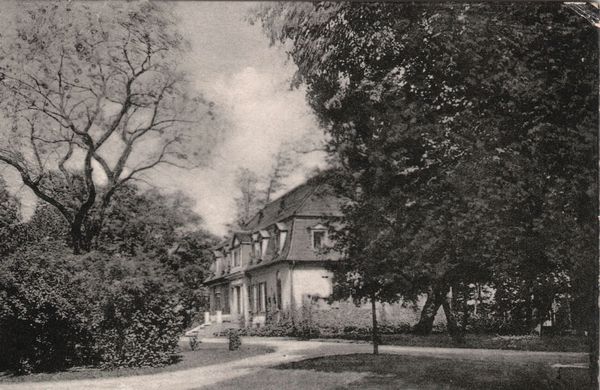
Freienhagen manor house, c. 1920. The Katzenellenbogen family had entrusted the Berlin architect Leo Nachtlicht (1872–1942) with the conversions
Freienhagen manor house, c. 1920, photographer unknown
© unknown; Repro: Berlinische Galerie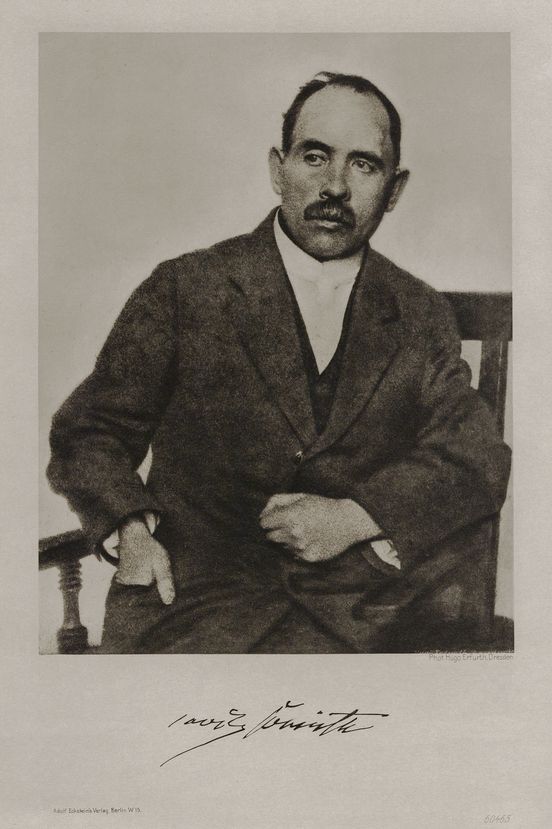
Lovis Corinth. Photogravure based on a photograph by Hugo Erfurt, 1919
Lovis Corinth. Photogravure based on a photograph by Hugo Erfurt, 1919
© Copyright has expired, Repro: Anja Elisabeth Witte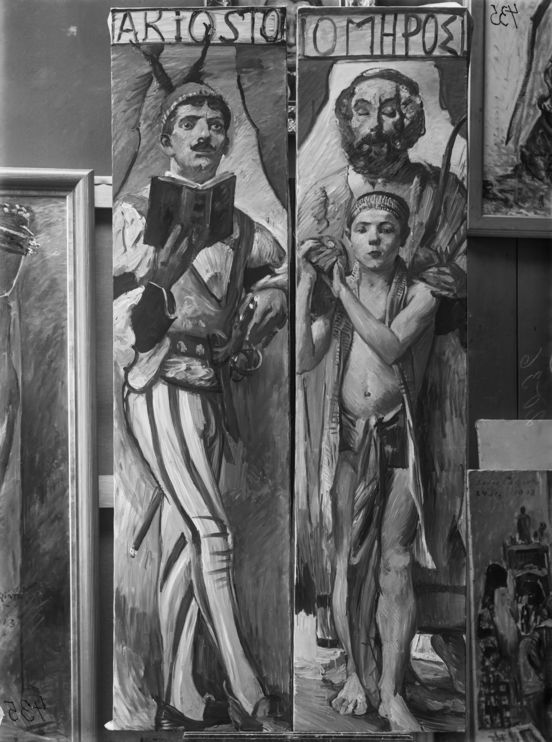
In Corinth’s studio: “Ariosto” and “Homer”, the Poets from the Katzenellenbogen Cycle
“Ariosto” and “Homer”, the Poets from the Katzenellenbogen Cycle
© Bildarchiv Foto Marburg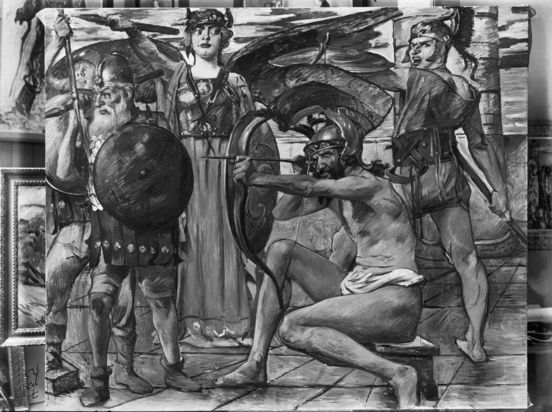
“Odysseus Slaying the Suitors”
“Odysseus Slaying the Suitors”, c. 1913/1914
© Bildarchiv Foto MarburgFreienhagen did not become the couple’s permanent home. Their marriage broke down in the late 1920s and the estate passed into other hands. The Cycle and other major works of art were awarded to Estella Katzenellenbogen, who then set up home in Berlin.
“… the walls were hung with French silks in various colours. There were paintings by Monet, Manet, Van Gogh, Cézanne and Menzel; there was even a Rubens. Max Liebermann had painted fine portraits of my father and my mother. […] My mother was a great collector with good taste.”
Konrad Kellen, born in 1913 as the son of Estella and Ludwig Katzenellenbogen, describes the décor at the Berlin address in his memoirs “Mein Boss, der Zauberer”, Hamburg 2011
Estella Katzenellenbogen was persecuted from 1933 because of her Jewish origins. Increasingly under threat, she initially left in 1936 and spent three years in Switzerland. In 1939 she returned briefly to Berlin before finally emigrating via Geneva and Genoa to the United States in 1940.
Her attempt to export the furnishings from her home in Berlin failed. The removal goods were seized and on 4 July 1941 the Gestapo instructed the revenue agency in Moabit-West to “realise the value”. Records compiled by the post-war compensation agency in Berlin show who bought Estella Katzenellenbogen’s property at the auction on 2 and 3 October 1941.
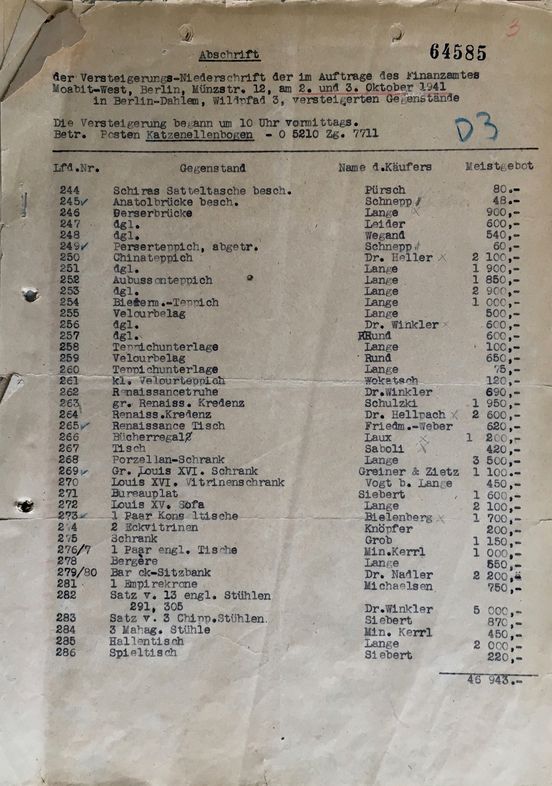
Transcription of the auction record
© Repro: Berlinische GalerieLovis Corinth’s Katzenellenbogen Cycle went on a different journey. Thanks to Estella Katzenellenbogen’s friendship with Walter Feilchenfeldt (1894–1953), who took over Paul Cassirer’s gallery after his death together with the art historian Grete Ring, the eleven canvases were rolled up for transportation to the company’s Amsterdam branch and deposited there in storage.
After the Second World War, Estella Katzenellenbogen, now living in California, recovered the paintings from Amsterdam. She divided the Cycle up between herself and her children Konrad, Leonie and Estella. In 1976, six of the motifs returned to Germany for a Corinth exhibition mounted by the Wallraf Richartz Museum at the Kunsthalle in Cologne. After the show, the canvases mounted on stretchers were brought to the recently founded Berlinische Galerie for inspection. The funds to purchase them were not available until 1980.
The Berlinische Galerie hopes to re-unite all the paintings in the Cycle and to reconstruct the original arrangement from the Katzenellenbogens’ dining-room at Freienhagen.
A first step towards this goal has been taken: with funds from the budget of the Federal Government Commissioner for Culture and the Media, the Federal State of Berlin and The Friends of the Berlinische Galerie, the Berlinische Galerie succeeded in purchasing the 1913 motif "Bacchant" from the Berlin art trade.
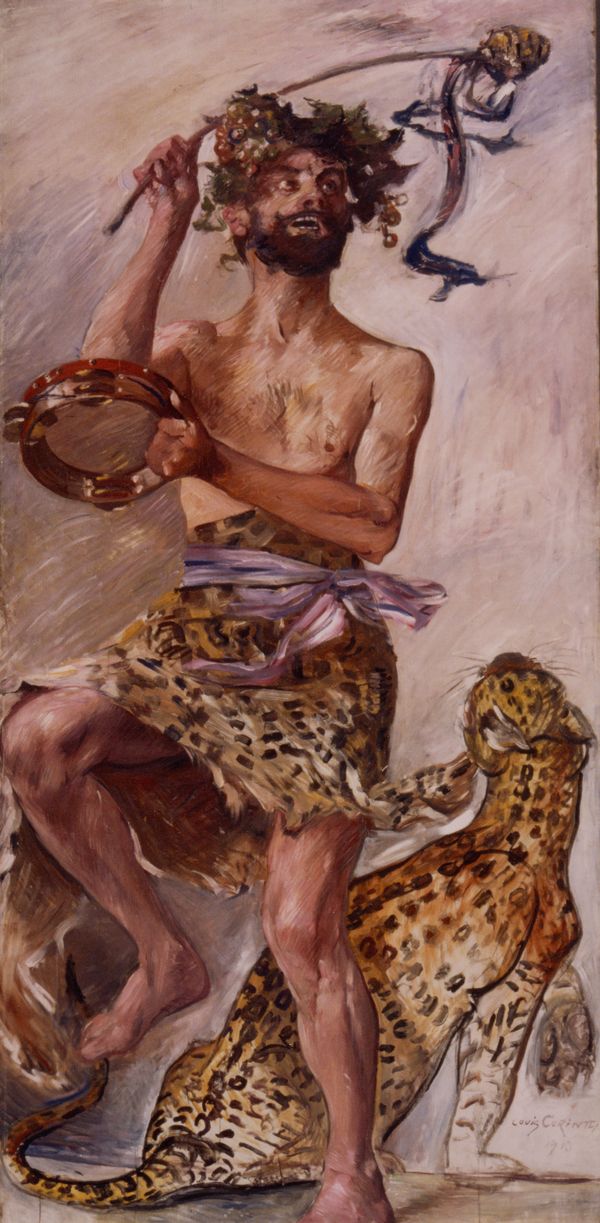
On offer at the Grisebach auction house in Berlin-Charlottenburg in November 2019: The "Bacchant" from the Katzenellenbogen Cycle.
Lovis Corinth, “The Bacchanal” from the Katzenellenbogen Cycle, 1913
© unknown; Repro: Berlinische Galerie